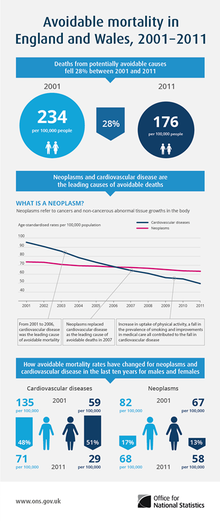epidemiology, preventable fraction for the population (PFp), is the proportion of incidents in the population that could be prevented by exposing the whole population...
2 KB (165 words) - 18:23, 19 July 2023
increases the risk, as opposed to reducing it, in which case its symmetrical notion is preventable fraction for the population. Multiple synonyms of the attributable...
6 KB (774 words) - 23:20, 13 September 2023
epidemiology, preventable fraction among the unexposed (PFu), is the proportion of incidents in the unexposed group that could be prevented by exposure...
1 KB (175 words) - 18:11, 28 May 2023
go through the increasingly complex process of clinical trials and regulatory procedures that lead to market approval. This demand for the clear articulation...
13 KB (1,487 words) - 08:44, 22 May 2024
is not the same as participation which means taking part in research, for example taking a drug in a clinical trial. Several organisations in the United...
42 KB (4,586 words) - 06:41, 20 May 2024
series design (measures on a sample or a series of samples from the same population are obtained several times before and after a manipulated event or...
10 KB (1,030 words) - 17:15, 26 February 2024
to a larger statistical population of units only if the experimental units are a random sample from the larger population; the probable error of such an...
42 KB (5,202 words) - 15:09, 3 April 2024
individual level and its contribution to preventable death at the societal level (PAF = Population Attributable Fraction). The multicohort study and meta-analysis...
20 KB (1,693 words) - 05:31, 15 January 2024
would become available at different times require investigation. For example, when the COVID-19 pandemic began, researchers predicted that there would...
12 KB (1,613 words) - 14:25, 15 May 2023
Risk difference (redirect from Population attributable fraction)
\neg E} . The risk difference can be written as R D = P ( D ∣ E ) − P ( D ∣ ¬ E ) . {\displaystyle RD=P(D\mid E)-P(D\mid \neg E).} Population Impact Measures...
5 KB (702 words) - 20:38, 13 May 2024




